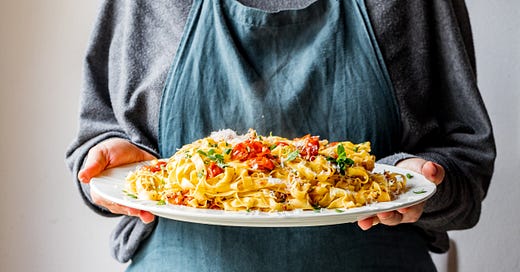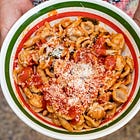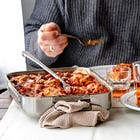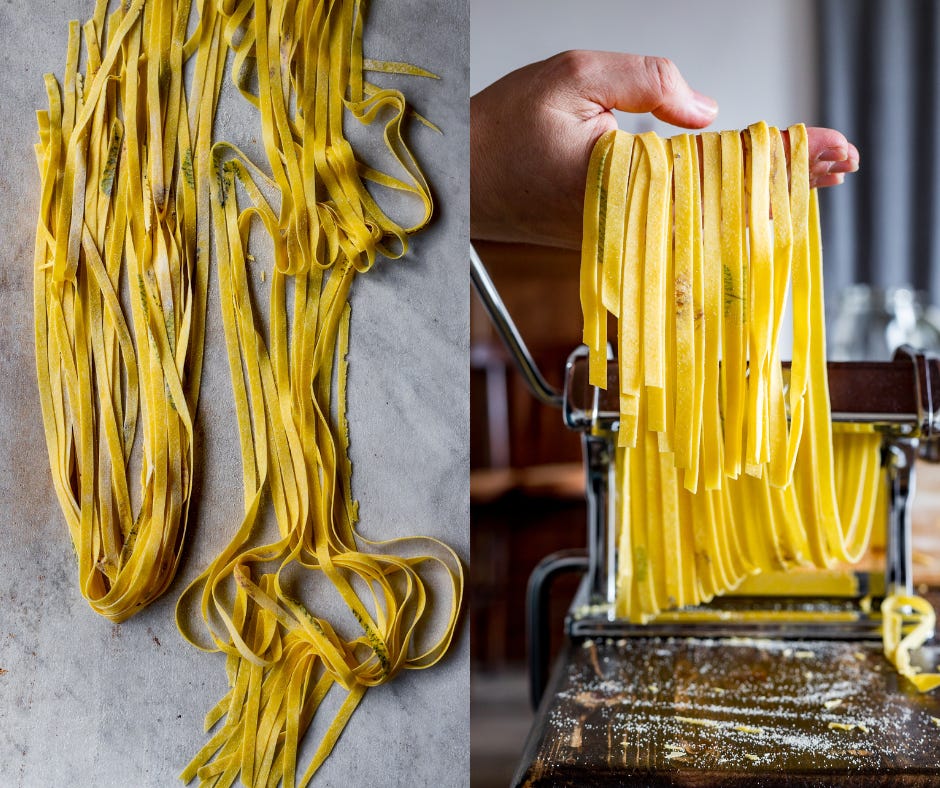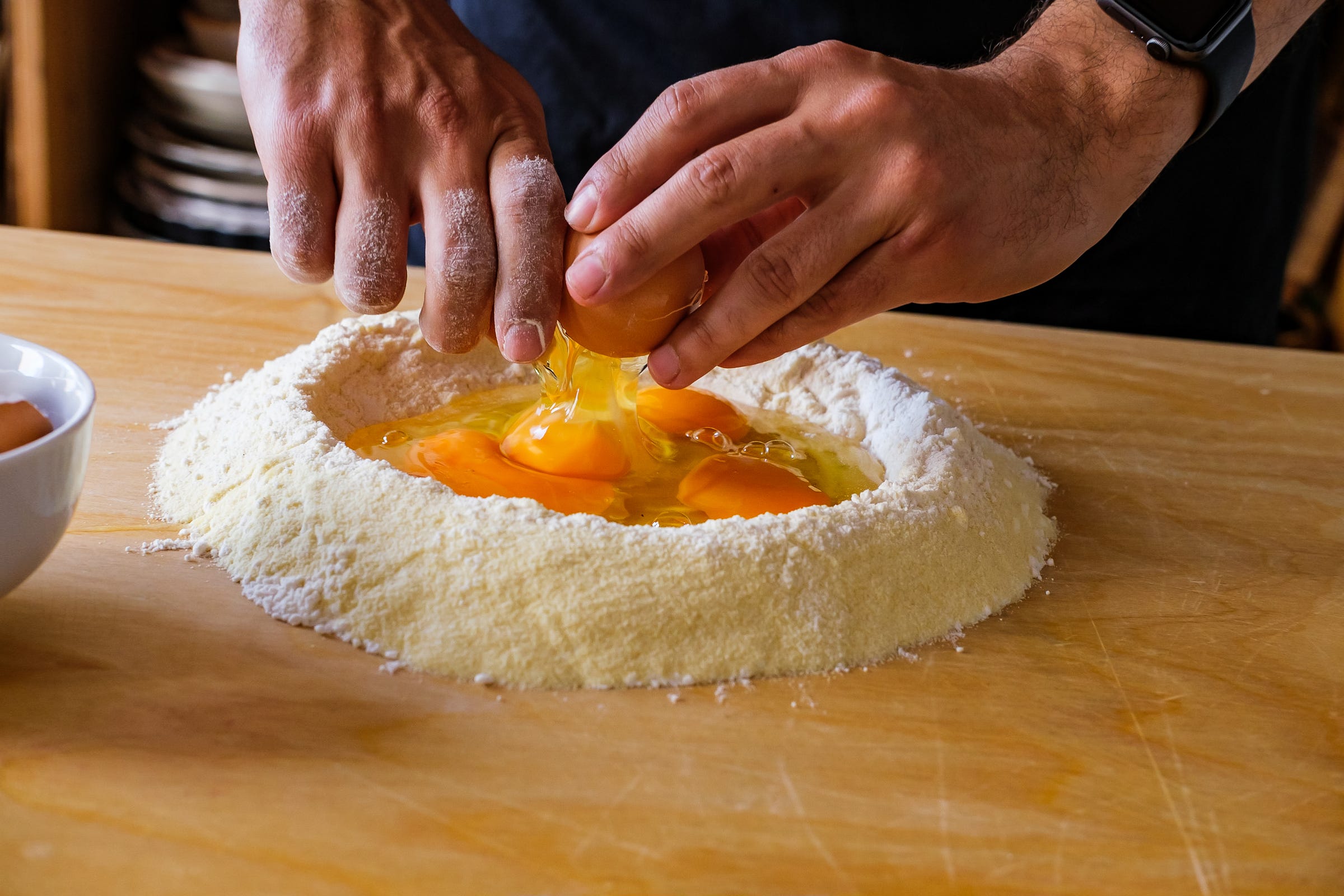Everything you want to know about fresh egg pasta
Meet me for our next exclusive Cook Along, on Sunday October 27th, 2024
UPDATE: If you are a paid subscriber, you can now access to the recording of our cook along about fresh egg pasta and enjoy every step of the class, along with the past videos of the previous cook alongs.
In my family, fresh pasta is for special occasions. Be it a holiday like Christmas or Easter, a family gathering, or a big dinner with friends, this is when you take out your wooden board, the rolling pin, and the pasta machine to make mounds of golden, silky sheets of dough.
Once you learn the basics of making fresh pasta, you have potentially endless possibilities. Tagliatelle, tagliolini, lasagne, pappardelle, tortelli, ravioli, maltagliati… you name one, and you can make it. They all start with the same versatile dough; what changes is simply the shape you cut your pasta into, and the ingredients you use to fill it—if you’re making a stuffed pasta—or layer it with—if you’re making lasagne.
Making fresh pasta is usually a family tradition, passed down from generation to generation. I learned to make it by spending hours with my grandma.
On Sunday, during our next cook-along, I’ll tell you everything I’ve learnt during these years of joyful experimenting and eating about homemade egg pasta.
The ingredients of fresh pasta
Fresh pasta has a very short ingredient list, the essential one being flour. Then you can opt for a dough with eggs, or without; in the latter case, the binding element is simply water. Additions of salt and a drop of extra virgin olive oil are regional or family preferences; they usually will not affect the proportions of the other ingredients, nor the final result of the recipe.
The kind of flour used to make fresh pasta differs enormously according to where you are in Italy.
In the North of Italy, and especially in Emilia Romagna, they usually make fresh pasta with 00 flour. This is the finest-ground flour, the most common type in Italian supermarkets, and the go-to option for most of our recipes. It results in a soft, silky, elastic dough, perfect for the delicate works of art that are tortellini, cappelletti, and anolini. These tiny stuffed parcels need a dough that is elastic and pliable, to easily embrace their filling: neat, dense little balls of meat, cooked in lard and mixed with breadcrumbs and Parmigiano Reggiano.
When you move to heavier, wetter fillings, such as potatoes or a mixture of ricotta and spinach, as is common in Tuscany, you’ll need a sturdy pasta dough that can contain the filling and its higher moisture level. This is when you’ll want to mix 00 flour with semolina flour.
The ratio of 00 flour and semolina flour in pasta changes from family to family, with a 50-50 proportion being the most common rule. 00 flour comes from soft wheat, while semolina comes from durum wheat. It is coarser, with a yellowish color and a rough texture, similar to corn flour. When used in pasta dough, it not only enhances the color and taste of the pasta, but also gives it a more rustic, porous texture. This kind of fresh pasta is therefore ideal for wet or heavy fillings, but also for hearty sauces like pork and beef ragù, or game meat sauce.
In the South of Italy, meanwhile, fresh pasta is typically made with just semolina and water: poor, simple, but with an incredibly intense flavor and color. This is the dough to curl into orecchiette and cavatelli, or roll into thin sheets to make the typical southern lasagne, layered with a rich meatball sauce, cheese, boiled eggs, and salami. It is also the same dough we use to make sagne ‘ncannulate.
If you feel like experimenting, you can of course use less traditional flours, such as whole wheat flour or spelt flour, for more rustic, nutty pasta. It is important to remember, though, that these recipes only work with flours that have a good amount of gluten. A rice flour or a corn flour, for example, wouldn’t work.
If you have never made fresh pasta before, this could be one of your next cooking projects. It just takes some practice, and then the movements will become natural. Making fresh pasta from scratch will become a soothing activity, a creative endeavor for a cold winter Sunday morning.
Begin with the following recipes, as they will give you the chance to experiment with the basic dough and some of the most classic variations.
Sunday Cook-Along: All About Fresh Egg Pasta
I hosted a special online cook-along on Sunday, October 27th, exclusively for all paid subscribers, where we explored the craft of egg pasta together. We dove into making tagliatelle, pappardelle, and tagliolini, using simple ingredients—flour and eggs—to create something quintessentially Italian. Whether participants were new to pasta making or had their pasta machine ready to go, it turned out to be a fun, hands-on experience for everyone to learn, share, and create together.
We had previously made cavatelli and orecchiette—and even rolled out pici by hand—but this time, we focused on the fascinating world of fresh egg pasta. I showed everyone how to pair these shapes with the perfect sauces and how to use a pasta machine—a tool that I truly believe can transform the pasta-making experience.
A recording of the class was made available for all paid subscribers after the event, making it easier for those living Down Under to join in virtually. (Here is the recording of our previous Cook Along when we made apple fritters and apple tart.) The recorded videos remain available on Substack, where we’re gradually building an archive of video recipes you can access anytime you need to refresh your technique for making orecchiette or ricotta gnocchi.
Thank you to everyone who participated!
But this cook-along isn’t just about making pasta. It’s about connection.
When you join, whether to cook or just watch and chat, you’re helping to support the work I do as a food writer. Every time you show up, it’s a vote of confidence in the value of storytelling and authentic Italian recipes.
If you’ve been enjoying Letters from Tuscany, our cook-alongs are one of the most intimate ways we can connect. It’s more than just a cooking class—it's a moment to slow down, chat, and share stories. Subscribing isn’t just about recipes or cook-alongs; it’s about saying, I believe in this, and I want to be part of it.
Your subscription makes all the difference. It allows me to continue sharing the heart of Italy with you through authentic recipes, insider guides, conversations with cookbook authors, and a behind-the-scenes look at the making of our upcoming cookbook. It’s a way to directly support this ongoing project, ensuring we can keep bringing a piece of Italy into your home, one story at a time.
Thank you for being here, and for supporting this journey. I look forward to cooking with you on the next Cook Along and beyond.
What you will find behind the paywall:
The recipe to make a classic fresh egg pasta
How to use a pasta machine
How to cut fresh pasta into different shapes
The recipe to make Spinach egg pasta
The recipe to make Squid ink egg pasta
The recipe to make Dried porcini egg pasta
The recipe to make Saffron egg pasta
The recipe to make Cocoa powder egg pasta
The recipe to make Beetroot egg pasta

